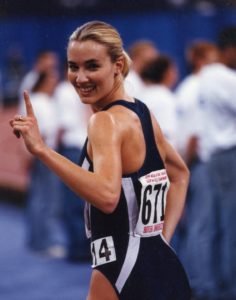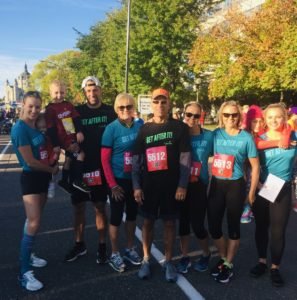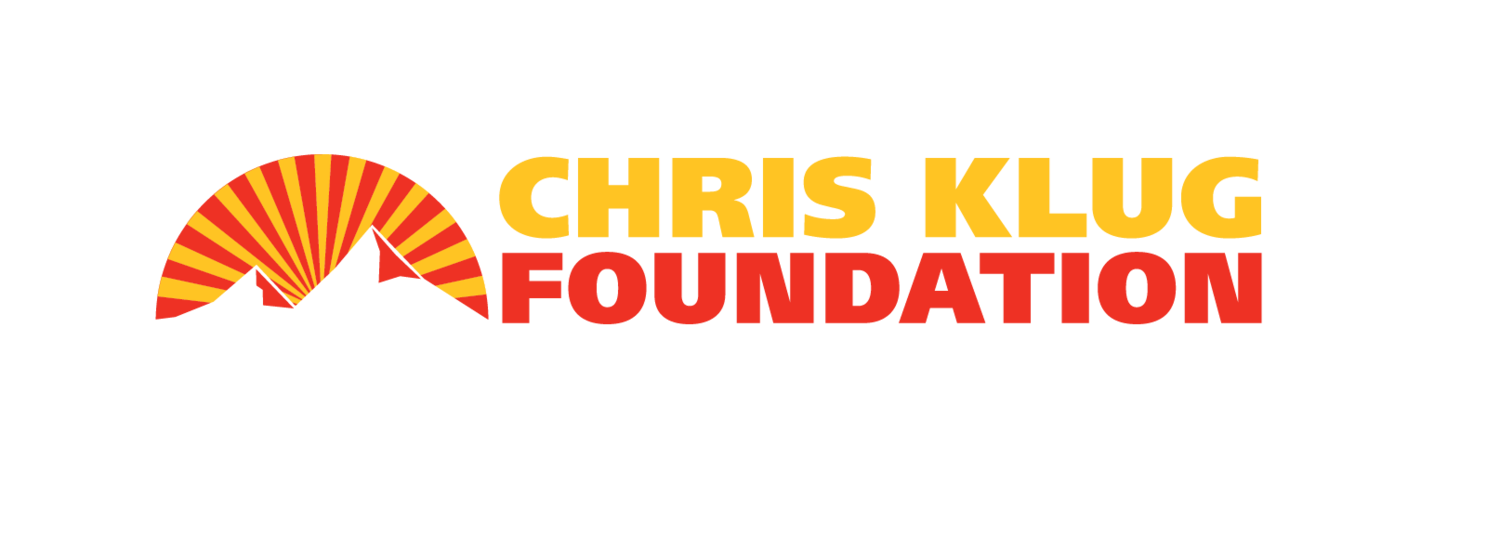Putting Her Best Foot Forward
The Chris Klug Foundation (CKF) recently met Carrie Tollefson, former Olympian and wife of Charlie Peterson, a mountain bike rider who will be competing on Team CKF in this year's Leadville 100 Mountain Bike (MTB) race on August 10th. Carrie is a world-class runner and Olympic athlete. She is also a tissue transplant recipient. We sat down with Carrie to talk about her transplant experience as well as her journey to the Olympics and beyond.Carrie Tollefson: I'm from Dawson, Minnesota. It's a rural farm town of about 1,600 people. In the state of Minnesota, you can start qualifying for running races in seventh grade, so that's really when I began competing in cross-country and track-and-field. I won 13 state championships in high school—five in cross-country—and ended up setting a national record. I won eight more state championships in track-and-field and, by that time, my athletic accolades were getting recognition in my small town. I had some fast wheels on me and just loved the sport of running. I attended Villanova University and that’s where I set my mind on pursuing a professional career in running. I won five National Collegiate Athletic Association (NCAA) championships while at Villanova. The first time I won was actually about a week after I found out about the bone tumor in my heel. When I initially got it checked out, doctors first discovered that I had a stress fracture in the fourth metatarsal of my left foot. From there, they also discovered a growth in the calcaneus (heel bone) of the same foot. At first, they didn't know whether it was a tumor or a bone cyst, but it was almost the same size as a 50¢ coin and it was directly underneath my ankle bone. The stress fracture was so small and the growth wasn't causing me any pain, so my doctors allowed me to continue running while keeping a close eye on both. The main concern was, if there were any changes to the tumor itself, my heel could potentially shatter, which would be very difficult to reconstruct, let alone continue my career as an endurance athlete. It could've been career-ending.CC Cunningham: Was the tumor caused by the stress fracture or was it unrelated?Carrie: It wasn’t related at all. The doctors don’t know how it happened—whether I had lived with it for my entire life or if it had developed over the years. It wasn’t related to my running. I'm so lucky I had the fracture in the same foot or else they may have never discovered the tumor!CC: Did the tumor impact your running ability before you had it removed?Carrie: Nope, I didn’t have any pain going into the surgery and no pain after they found it. Typically, you have pain if something isn’t right body-wise, but I was lucky I didn’t experience that. I was at the peak of my career at the time. Emotionally, I was flying and felt so good. I also think I got a motivational boost from knowing that something was physically wrong with me but succeeding through it.After winning that first NCAA championship in 1997, I went home for Christmas break in December and had to have another MRI—I was getting an MRI every eight weeks at that point. It was then that my doctors finally told me it was time to remove the tumor from my heel. They detected a "hot spot" in the tumor and weren't sure if it was growing or if something was going on inside the tumor itself (or both).For the surgery, the doctors initially wanted to take bone from my femur, but they were worried it would cause chronic pain from cutting through my leg muscle. They decided on a tissue transplant—a bone graft from a deceased donor.I had the surgery on February 2nd, 1998. When the orthopedic surgeons went in, the actual tumor had dried up and it was bone-on-bone. If they didn’t operate when they did, my heel probably would’ve shattered without me knowing because I hadn’t experienced any pain whatsoever.Looking back, it was kind of like the worst-case scenario for a long-distance runner—that type of injury, that location. Once I healed up, I never looked back. It was a true blessing for me to receive that donor bone. It has given me the chance to live a life full of running.CC: How was the recovery post-transplant?Carrie: It was pretty tough, to be honest. The surgeons cut through the side of my foot and I still have a small scar (although it's faded over the years)—about two inches long on the left side of my foot. I couldn't put any weight on my heel for two months. I was in a boot and used crutches to get around during that time. By the third month, I was lightly walking with the boot still on. By month four, in June, I took my first step without the boot and that's when I began running again.I was able to return to Villanova in time for the season, but I wasn’t quite myself. That year, I led my team to the NCAA championships in cross-country but finished 11th individually. Even though I didn't win individually like I had the year before, our team ended up winning the championship that year. I won four more individual NCAA championship titles with the donated bone after that.CC: Were there any complications with the donor bone post-transplant?Carrie: No, there wasn’t any rejection of it. The transplanted bone actually stimulates my bones around it and it basically fused into the existing bones in my foot. I'm not even sure you can say I still have that donor tissue since my foot kind of "adopted" it in a way.CC: Can you tell me more about your experience competing in the Olympics?Carrie: Two and a half years after my transplant, I had the opportunity to try out for track-and-field in the 2000 U.S. Olympic Trials. I didn't qualify that year, but I came back in ’04. I actually didn’t qualify for the U.S. Olympic Team in my main event—the 5000m—but I surprised everyone by winning the 1500m.The 2004 Summer Olympic Games were held in Athens, Greece, so I traveled there to compete for Team USA in track-and-field. Unfortunately, I was the second person who didn’t make the final in my semis, which was kind of a bummer, but I was just stoked to be there and represent my country as part of the team.After the Olympics, I ran for another six solid years before my husband, Charlie, and I had our first child. Since then, I’ve been doing a lot of television work for all the main networks—ESPN, ABC, NBC. I’m a commentator for major marathons and track-and-field events all over the country and for some international running events. I enjoy being a woman on the run. I’ve got three children now with Charlie. We’ve been blessed.
I attended Villanova University and that’s where I set my mind on pursuing a professional career in running. I won five National Collegiate Athletic Association (NCAA) championships while at Villanova. The first time I won was actually about a week after I found out about the bone tumor in my heel. When I initially got it checked out, doctors first discovered that I had a stress fracture in the fourth metatarsal of my left foot. From there, they also discovered a growth in the calcaneus (heel bone) of the same foot. At first, they didn't know whether it was a tumor or a bone cyst, but it was almost the same size as a 50¢ coin and it was directly underneath my ankle bone. The stress fracture was so small and the growth wasn't causing me any pain, so my doctors allowed me to continue running while keeping a close eye on both. The main concern was, if there were any changes to the tumor itself, my heel could potentially shatter, which would be very difficult to reconstruct, let alone continue my career as an endurance athlete. It could've been career-ending.CC Cunningham: Was the tumor caused by the stress fracture or was it unrelated?Carrie: It wasn’t related at all. The doctors don’t know how it happened—whether I had lived with it for my entire life or if it had developed over the years. It wasn’t related to my running. I'm so lucky I had the fracture in the same foot or else they may have never discovered the tumor!CC: Did the tumor impact your running ability before you had it removed?Carrie: Nope, I didn’t have any pain going into the surgery and no pain after they found it. Typically, you have pain if something isn’t right body-wise, but I was lucky I didn’t experience that. I was at the peak of my career at the time. Emotionally, I was flying and felt so good. I also think I got a motivational boost from knowing that something was physically wrong with me but succeeding through it.After winning that first NCAA championship in 1997, I went home for Christmas break in December and had to have another MRI—I was getting an MRI every eight weeks at that point. It was then that my doctors finally told me it was time to remove the tumor from my heel. They detected a "hot spot" in the tumor and weren't sure if it was growing or if something was going on inside the tumor itself (or both).For the surgery, the doctors initially wanted to take bone from my femur, but they were worried it would cause chronic pain from cutting through my leg muscle. They decided on a tissue transplant—a bone graft from a deceased donor.I had the surgery on February 2nd, 1998. When the orthopedic surgeons went in, the actual tumor had dried up and it was bone-on-bone. If they didn’t operate when they did, my heel probably would’ve shattered without me knowing because I hadn’t experienced any pain whatsoever.Looking back, it was kind of like the worst-case scenario for a long-distance runner—that type of injury, that location. Once I healed up, I never looked back. It was a true blessing for me to receive that donor bone. It has given me the chance to live a life full of running.CC: How was the recovery post-transplant?Carrie: It was pretty tough, to be honest. The surgeons cut through the side of my foot and I still have a small scar (although it's faded over the years)—about two inches long on the left side of my foot. I couldn't put any weight on my heel for two months. I was in a boot and used crutches to get around during that time. By the third month, I was lightly walking with the boot still on. By month four, in June, I took my first step without the boot and that's when I began running again.I was able to return to Villanova in time for the season, but I wasn’t quite myself. That year, I led my team to the NCAA championships in cross-country but finished 11th individually. Even though I didn't win individually like I had the year before, our team ended up winning the championship that year. I won four more individual NCAA championship titles with the donated bone after that.CC: Were there any complications with the donor bone post-transplant?Carrie: No, there wasn’t any rejection of it. The transplanted bone actually stimulates my bones around it and it basically fused into the existing bones in my foot. I'm not even sure you can say I still have that donor tissue since my foot kind of "adopted" it in a way.CC: Can you tell me more about your experience competing in the Olympics?Carrie: Two and a half years after my transplant, I had the opportunity to try out for track-and-field in the 2000 U.S. Olympic Trials. I didn't qualify that year, but I came back in ’04. I actually didn’t qualify for the U.S. Olympic Team in my main event—the 5000m—but I surprised everyone by winning the 1500m.The 2004 Summer Olympic Games were held in Athens, Greece, so I traveled there to compete for Team USA in track-and-field. Unfortunately, I was the second person who didn’t make the final in my semis, which was kind of a bummer, but I was just stoked to be there and represent my country as part of the team.After the Olympics, I ran for another six solid years before my husband, Charlie, and I had our first child. Since then, I’ve been doing a lot of television work for all the main networks—ESPN, ABC, NBC. I’m a commentator for major marathons and track-and-field events all over the country and for some international running events. I enjoy being a woman on the run. I’ve got three children now with Charlie. We’ve been blessed. CC: Have you ever tried to find out who your tissue donor was?Carrie: Charlie and I talk all the time about how special it was that I received this second chance to pursue my running career. The whole experience gave me this new sense of determination and wanting to be better because I had received this gift.Charlie always says, "Carrie, we should find out who gave you this piece of them. We should try to meet their family." At the time of my transplant, not many people were trying to find out who donated their tissue or their organs to them, but I would love to know who gave me theirs. I’m not sure if we still have the ability to find out.All I know is that I owe them so much. My whole mentality—how I live my life—if I didn’t have running, I’d be a totally different person. They have allowed me to live such a fulfilling, active life and have given me the opportunity to pursue a truly rewarding, meaningful career.Carrie and her husband, Charlie, will be joining us in Leadville on August 10th with their three children. Carrie will be volunteering at the CKF aid stations along the Leadville 100 MTB course and Charlie will be competing in the race for the first time. Please consider donating to Charlie's fundraising efforts.Original interview transcribed, edited, and rewritten by CC Cunningham, CKF Program Manager.
CC: Have you ever tried to find out who your tissue donor was?Carrie: Charlie and I talk all the time about how special it was that I received this second chance to pursue my running career. The whole experience gave me this new sense of determination and wanting to be better because I had received this gift.Charlie always says, "Carrie, we should find out who gave you this piece of them. We should try to meet their family." At the time of my transplant, not many people were trying to find out who donated their tissue or their organs to them, but I would love to know who gave me theirs. I’m not sure if we still have the ability to find out.All I know is that I owe them so much. My whole mentality—how I live my life—if I didn’t have running, I’d be a totally different person. They have allowed me to live such a fulfilling, active life and have given me the opportunity to pursue a truly rewarding, meaningful career.Carrie and her husband, Charlie, will be joining us in Leadville on August 10th with their three children. Carrie will be volunteering at the CKF aid stations along the Leadville 100 MTB course and Charlie will be competing in the race for the first time. Please consider donating to Charlie's fundraising efforts.Original interview transcribed, edited, and rewritten by CC Cunningham, CKF Program Manager.
